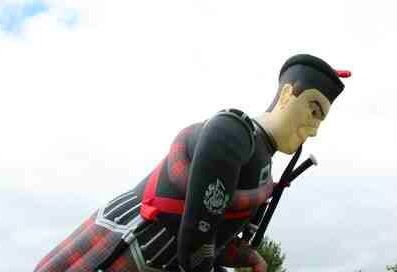Balloonomania gripped Britain in the late 18th and early 19th century. Sparked by the Montgolfier Brothers’ first hot air balloon trials in 1783, a mania gripped France and quickly spread to the British Isles. Ladies dressed in voluminous skirts, the men donned balloon-shaped bonnets, and hot air balloons were painted on every piece of crockery everywhere. Poets also joined in the frenzy, with Romantics like Samuel Taylor Coleridge describing the balloon as, “an image of human longing and inspiration, both uplifting and terrifying”.
In Edinburgh, a Scotsman named James Tytler saw an opportunity to end his run of bad luck. Buoyed by the Montgolfier’s success and determined to be the first aeronaut in Britain, Tytler was somewhat short on cash but he didn’t let that deflate his belief that now was his time to (literally) rise up in the world.
By this point, Tytler was already a jack of all trades; pharmacist, doctor, preacher, artist, and oddly, both the editor of The Encyclopedia Britannica and the infamous Ranger’s Impartial List of the Ladies of Pleasure in Edinburgh. However, he had yet to master how to make steady money from any of his numerous pursuits.
Born in Fern, Forfarshire (now Angus) to a Presbyterian minister, Tytler became a preacher before studying medicine at the University of Edinburgh. After his apprenticeship as a ship’s surgeon, he opened a pharmacy in Leith which became his first financial failure. Riddled with debt, Tytler fled from his creditors with his wife and children to England. When the coast was clear he returned to Edinburgh in 1773 just as Balloonomania was sweeping the country.
Despite being down on his luck, hope rose in Tytler. The daring flights of French aeronauts had seen them become celebrities with thousands-strong crowds flocking to their launches. If they could do it, so could he.
Tytler was a well-kent face in Edinburgh, known for his radical political views and eccentricity. The fact that he was hopelessly in debt didn’t deter folk from contributing to his cause — a sign of how much everyone had been engulfed by Balloonomania. Tytler succeeded in raising the funds to bring his ‘Edinburgh Fire Balloon’ to life.
At first, the fire balloon was a flop, only lifting a few feet from Edinburgh soil. But Tytler persisted and on the 27th of August, 1784, his creation was up, up and away. The Edinburgh Fire Balloon lifted to 350ft and traveled from Holyrood Park to Restalrig village — a distance of half a mile. Unfortunately, only a handful of spectators had gathered to witness the triumph of Tytler’s sailcloth contraption so he hastily scheduled a follow-up flight.
The achievement may sound modest compared to later advancements, but those who had witnessed Tytler’s flight hailed him a hero and their enthusiasm ignited public interest. This time Tytler charged spectators for the privilege of seeing the Edinburgh Fire Balloon in action.
Sadly, Tytler’s bad luck continued to haunt him. The balloon failed to fly and Tytler’s dream of money and fame came crashing down to Earth. The fervour of Balloonomania in the late 1700s was such that when a balloon display failed to impress the audience turned on the aeronauts with fury. To entertain crowds in France the Montgolfier Brothers launched a cockerel, duck, and sheep into the air. Riots often broke out and records document how restless spectators would destroy balloons that either failed to launch or didn’t launch quickly enough. In Edinburgh, it would be nearly two hundred years before the Festival Fringe arrived to provide bored punters with round-the-clock summer entertainment. As it was, Tytler became an outlet for his audience’s intense disappointment.
Hero for a day, Tytler was ridiculed by both the public and the press for his failure. His fate was sealed when Vincenzo Lunardi, the “Daredevil Aeronaut” arrived in Scotland and flew his ‘aerostatic machine’ 46 miles from Lauriston, Edinburgh to Ceres, Fife.
Financially bankrupt, further misfortune followed Tytler when his wife, Elizabeth Rattray, demanded a divorce. She’d discovered her husband was a bigamist and that for the past decade, he’d been secretly living with a second wife and their twin daughters.
While some of Tytler’s misfortune can be blamed on sheer bad luck, he seemed to have a habit of getting himself into hot water. Bankrupt and divorced, he was eventually outlawed from Edinburgh for praising the French Revolution and denouncing the monarchy. Tytler lived out his last days in Salem, Massachusetts as an apothecary and editor. He went missing on the 7th of January 1804, allegedly in a state of drunkenness. His body washed up on the shore two days later.
Despite his failures, Tytler left his mark as the first man to fly a hot air balloon in Britain, a remarkable achievement that is still remembered today in the street named Tytler Gardens, near Holyrood.




